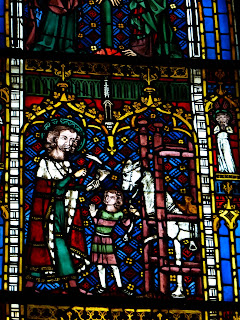A holiday in Alsace, in the celebrated village of Riquewihr. All new to me, and stemming from a recommendation from a cycling friend years ago.
Alsace reminded me in some ways of Belgium: a place that has had the tides of history sweep through it, yet remained itself. The gabled, ornamented architecture of a prosperous merchant class, a religious rubbing-along when money is to be made, the superlative artists brought to that area by that disposable wealth and taste for ostentation. The vigneron who lived in one fine house in Riquewihr had himself depicted being pulled away from his agreeable existence by Death (rather than the end of his week in a gite):
There's a fine tradition of shop signs:
This statue in Colmar is of Schwendi, excitedly brandishing not one of his weapons, but roots of the Tokay vine, which he'd brought back from a campaign in Hungary. That's a very Alsatian thing to commemorate:
A Belgium, though, with sun, and mountains, and hectares of vineyards - all that cool and smooth Reisling instead of beer-brewing. But with Germanic or Belgian moments: some mildly pornographic beer bottle labels caught my eye.
I had never seen these before, the White Storks, or heard their beaks clattering after they fly in from the fields by the Rhine:
Of course, I was at times keen to stay in early modern mode, and here I am, looking (I think) quite the part:
My chief artistic find was in this superbly-housed gallery, the Augustinermuseum in Freiburg (we motored into Germany for a day). Those are the original statues from the niches on the cathedral, elongated to be seen from pavement level.
It's a Sundenfall, a Fall of Man, carved in boxwood by Meister H.L., who was active c.1511-33. The tree of knowledge is a fig tree, its distinctive leaves carved with astonishing delicacy. There's no flattening, everything is rendered in the round.
I like the choice of a fig as the forbidden fruit.
Durer's parrot sits up the tree:
Freiburg also offers a Cathedral with extraordinary stained glass, all in the most vibrant colours. Those in the nave were funded by the city's guilds, so you have a shoemakers' window, one from the tailors, the breadmakers - and amongst these windows, one that you could only imagine had been sponsored by the torturers and executioners' guild (or, as Abhorson would say, 'our mystery'). Eye-poppingly hideous deaths
I shall have to ask medievalist colleagues to identify the saint depicted below. It must be some crazy yarn from the Golden Legend. I saw the motif in a painting in the Colmar Unterlinden museum, and here again in the glass at Freiburg. As you see, the saint shoes a horse by lopping off the horse's leg, nailing on the horseshoe to the hoof, and he then must re-attach the leg without causing the animal any inconvenience or pain. The magical act of the saint reminds me of the Alpine stories of the feasts of beef at sabbats with the nachstvolk, when the bones of the animal had to be placed back in the skin, and the animal would be alive again in the morning (though never quite as strong for work).
There's a concentration of villages fleuries around here, done so intensely that the car parks have notices explaining that the funds from parking charges go to the floral display in the village you are about to visit.
I wanted wildflowers, and at the top of the ridge by the Auberge de Heucote, and at the top of the Ballon D'Alsace, we found orchids that were long 'gone over' this year back in England, but in their prime at 2,000 to 3,000 metres in July in France. The French seem to call the Butterfly orchid the Orchidee de Montagne.
I was very mildly excited to find this solitary example of an orchid I'd never seen in the UK. It turns out to be the Small White Orchid: a suitably boring name for what must be one of the most boring of its kind:
New to me was Pilosella, or 'The Devil's Paintbrush' (now, that's a plant name for you). It's just a garden escape in this country, and classified as a noxious weed in other parts of the world where it is also spreading from gardens. But protected in its native habitat.
Nor had I ever seen a Spiked Rampion:
or really taken in the Yellow Gentians (The very bitter-tasted root used to be used in beer-making. The French, divided as ever between hypochondria and enjoyment of alcohol, still make a 'liqueur de gentiane' out of it.)
or such sheets of Bistort
The Unterlinden gallery in Colmar has the Issenheim altarpiece by Grunewald: a gallery in itself, bringing together art from the medieval period down to images that anticipate Blake. But I may post another time on that intense experience. Colmar also has this variant of Cranach's Melancholia - she aimlessly whittles at a stick, as the night-army hurtles through the sky, a mad mixture of mercenary landesknechts and witches.
























